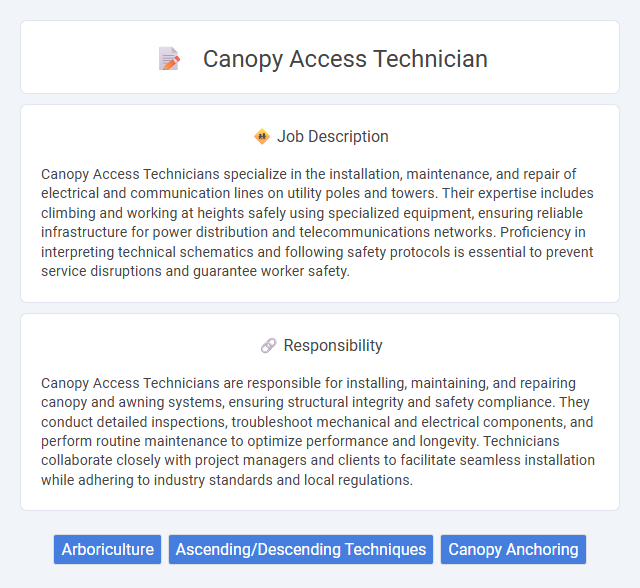
Canopy Access Technicians specialize in the installation, maintenance, and repair of electrical and communication lines on utility poles and towers. Their expertise includes climbing and working at heights safely using specialized equipment, ensuring reliable infrastructure for power distribution and telecommunications networks. Proficiency in interpreting technical schematics and following safety protocols is essential to prevent service disruptions and guarantee worker safety.
Individuals with a strong sense of balance, physical fitness, and comfort working at heights are likely to be well-suited for a Canopy Access Technician role. Those with a fear of heights or limited upper body strength may find the job challenging and potentially unsuitable due to the demanding nature of climbing and rigging equipment. The probability of success in this position increases for candidates who demonstrate agility, attention to safety protocols, and the ability to work in varying weather conditions.
Qualification
Canopy Access Technicians must possess specialized training in rope access techniques, certified by recognized bodies such as IRATA or SPRAT, to ensure safe and efficient operations at height. Candidates should demonstrate strong physical fitness, problem-solving abilities, and knowledge of industrial safety standards relevant to working in confined spaces and elevated environments. Proficiency in equipment inspection, rigging, and adherence to OSHA regulations also qualifies technicians for effective execution of canopy maintenance and installation tasks.
Responsibility
Canopy Access Technicians are responsible for installing, maintaining, and repairing canopy and awning systems, ensuring structural integrity and safety compliance. They conduct detailed inspections, troubleshoot mechanical and electrical components, and perform routine maintenance to optimize performance and longevity. Technicians collaborate closely with project managers and clients to facilitate seamless installation while adhering to industry standards and local regulations.
Benefit
Canopy Access Technician roles likely offer competitive salaries and opportunities for career advancement within telecommunications or arboriculture industries. Benefits often include comprehensive health insurance, retirement plans, and paid time off, contributing to job security and employee well-being. Access to specialized training and equipment may further enhance professional skills and safety on the job.
Challenge
Canopy Access Technicians likely face the challenge of working at significant heights, requiring strict adherence to safety protocols to minimize risk. The role probably demands strong problem-solving skills to troubleshoot installation or maintenance issues in various weather conditions. Physical endurance and technical expertise are essential to efficiently handle equipment and ensure reliable canopy system performance.
Career Advancement
Canopy Access Technicians gain valuable skills in rigging, climbing, and safety protocols essential for working in tree care and utility line inspection. Mastery in these areas opens pathways to advanced roles such as arborist, aerial lift operator, or safety supervisor, offering increased responsibility and higher earning potential. Continuous training and certifications in industry standards like ISA or OSHA significantly enhance career growth opportunities within environmental services and infrastructure maintenance sectors.
Key Terms
Arboriculture
Canopy Access Technicians specialize in arboriculture by safely navigating tree canopies using ropes and harnesses to perform detailed inspections, pruning, and maintenance. Expertise in tree physiology, identification, and health assessment is essential for effective management of urban forests and ecological conservation. Their work ensures tree safety and vitality, preventing hazards and promoting sustainable urban environments.
Ascending/Descending Techniques
Canopy Access Technicians specialize in ascending and descending techniques to safely maneuver through tree canopies, utilizing methods such as rope climbing, harnessing, and mechanical ascenders. Expertise in these techniques ensures efficient access to various canopy heights for tasks like pruning, inspection, and research while minimizing risk. Proficiency in knot tying, fall protection, and equipment maintenance is critical for maintaining safety and operational effectiveness.
Canopy Anchoring
Canopy Access Technicians specialize in securing safe and reliable anchor points within tree canopies to facilitate access and work at height. Expertise in canopy anchoring involves selecting structurally sound branches or trunks and utilizing certified hardware like slings, carabiners, and dynamic ropes to ensure stability and safety. Mastery of these anchoring techniques minimizes the risk of falls and supports efficient tree climbing and maintenance operations.
 kuljobs.com
kuljobs.com